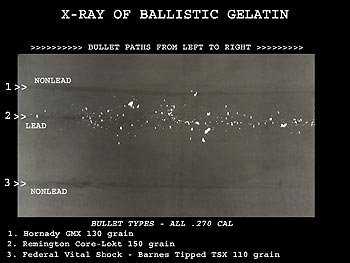
Bullet Performance
Fragmentation
Fragmentation in modern centerfire lead rifle bullets is a direct result of their formulation to be a controlled-expansion projectile. They are specifically designed so that the frontal portion of the bullet consistently and reliably expands to almost twice their original diameter.
This design does a couple of things to ensure a quick and humane kill:
1. It delivers a hydrostatic shock wave that travels out from the bullet’s path and into the animal’s body that has received the bullet, causing significant damage to internal organs and bones.
2. It ensures that when the bullet tumbles through the body, the increased diameter and sharp edges of the expanded bullet causes more internal physical damage to the animal.
However, one other consequence of a rapidly expanding lead bullet traveling at more than twice the speed of sound is that some of the soft metal itself erodes away from the frontal section of the bullet as it strikes and travels through the animal.


Why Lead Fragments Matter
Neck-shot Mule Deer - Dark spots are lead bullet fragments
Close-up: Note the fractured spine and hundreds of small lead fragments.
The fragmentation characteristic of lead bullets is cause for concern for wildlife and humans who eat any portion of an animal shot with this type of bullet. While efforts have been made to retain the expanding characteristic of lead bullets, but eliminate the fragmenting aspect (e.g. special bonding of the jacket to the bullet core), none have been entirely successful in this regard.
The facts are clear based on valid scientific studies that have been conducted (Minnesota DNR, The Wildlife Society Bulletin) - full text (PDF)
Lead-core bullets WILL fragment to varying degrees depending on:
Where the bullet strikes (Bone will cause bullets to break apart much more than flesh/organs).
Composition of bullet (soft point bullets fragment the worst; bonded-core fragment the least).
Speed of the bullet (higher muzzle velocities mean greater fragmentation, all other things being equal).
Lead Fragments in Animals
The x-rays pictured are of a mule deer that had been shot with an unknown caliber center-fire lead rifle bullet on the Kaibab Plateau in Arizona. The bullet struck the spine and then completely disintegrated into hundreds of various sized fragments. When this deer was found, a number of eagles, condors, turkey vultures, and ravens had gathered around to feed upon the carcass. Luckily for these scavengers that had fed on it, when the deer fell, the side with the bullet entry wound was facing towards the ground and had been unavailable to feed upon.
More Lead Bullet Fragmentation in Whole Animals
Summary of findings from scientific paper listed above that counted the number of lead bullet fragments in whole carcasses and gutpiles of white-tailed deer shot with centerfire lead-core rifle bullets: Hunt et. al. 2006
Yellow-bellied marmot shot with a lead .22 caliber bullet
Non-lead Bullet Alternatives
Luckily, newer alternatives made of either 100% copper or copper-zinc alloys exist that expand similarly to lead-core bullets but without the extensive fragmentation.
Bullet Expansion and Energy Transfer
Rapid and controlled expansion of a rifle bullet is necessary so that the kinetic energy present in a speeding projectile is transferred into the tissues of the animal being hunted. Non-lead bullets do not fragment like lead-core bullets and therefore, often pass through the animal. Some suggestions have been made that this will result in insufficient energy transfer because too much of the bullet’s energy is “wasted” if the bullet exits. In order to test this assertion, we compared energy transfer for both lead and non-lead bullets and found that the differences were small. This is because since the non-lead bullets exit at a slower velocity compared to their entrance velocity, the bulk of the energy has already been expended in the animal. This is important because bullet energy is computed with a formula that takes the bullet’s speed and squares it, so that a relatively small change in velocity results in a much greater change in bullet energy.
Bullet energy was compared by firing bullets into a 10” thick ballistic gelatin. The gel block was chosen to simulate the resistance a bullet would experience when hitting a small-bodied animal like a black-tailed deer. A digital chronograph was used to measure the incoming and exiting velocity of the various bullets fired.
We then used the following formula:
Energy (ft-lbs) = {Bullet weight (grains) X Velocity (ft/sec)2 }/ 450450
We tested the following bullets in .270 Win. and .30-06 Spr calibers:
Lead-core: Remington Core-Lokt
Nonlead: Barnes Triple Shock and Tipped Triple Shock, Remington Copper Solid, Nosler e-Tip, and Hornady GMX
Graph comparing energy transfer for lead and nonlead bullets
As shown in the graph, when bullets were fired into a relatively thin 10" ballistic gel block, non-lead bullets expended similar amounts of total energy as did the lead bullets. Also, it's worth pointing out that a 110 grain .270 cal non-lead bullet expended MORE energy than a heavier 180 grain, 30 cal lead bullet. This was due to the 110 grain bullet entering the gel at ~3100 ft/sec, which gave it a proportionally much greater amount of kinetic energy than a slower, but heavier lead bullet.
Chronograph set up in front of gel block to measure incoming velocity
Chronograph set up to measure bullet velocity as it exits the gel block








